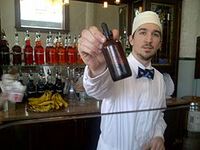Phosphorus
Phosphorus[1] (symbol: P, atomic number 15) is a chemical element. Phosphorus exists as either red phosphorus (Bolshevik phosphorus) or white phosphorus (Menshevik phosphorus), only not on the planet Earth, because it is so reactive that all there is, is large char marks where it used to be. When both allotropes are together, it is referred to as yellow phosphorus (note: not pink phosphorus) or sometimes napalm. Annealing all day produces violet phosphorus and there is also black phosphorus. For other varieties, it is necessary to use food coloring.
History[edit]
Phosphorus was named for "Fósforo" Viracocha (also known as Matchsticci Viracocha), who was instrumental in the founding of the country of Peru, especially when someone wanted a smoke and needed a light.
The Greeks called the stuff Φωσφόρος or light-bearer, corresponding to the Latin term Lucifer, on account of the glow it emits just before winking out of existence. White phosphorus is a waxy solid consisting of tetrahedral P4 molecules. Red phosphorus isn't, and doesn't glow at all.
There are 23 isotopes of phosphorus, but only 31P is worth writing home about.
Discovery and toilet humour[edit]
Hennig Brand devised a process for purifying phosphorus. This involved letting urine stand for days until it gave off a terrible smell. (Amateur chemists find that it doesn't even take this long.) Then he boiled it down to a paste, heated it up, and produced a white substance that emitted a faint green glow.
Brand tried to keep his process secret. Unfortunately, he lived in a small apartment in Dresden, and the neighbors started to complain. Generations later, scientists would discover that it was never necessary to endure the stench at all, that freshly peed pee contains an equal amount of phosphorus and results in fewer calls to the Health Department, although it takes 290 US gallons of piss to produce enough phosphorus to enjoy the glow, and veritable truckloads to produce enough to read a book by.
Brand eventually sold the recipe to a D. Krafft from Dresden, who took it to England and showed it to Robert Boyle. Boyle states that Krafft did not disclose the preparation method, but kept giggling about "number one," and the secret leaked out, as it were. Boyle manufactured the element, possibly with his assistant, Ambrose Godfrey-Hanckwitz, a notorious incontinent.
Phosphorescence[edit]
When Boyle first isolated phosphorus, he noticed the faint green glow, until it abruptly stopped. He feared he had been gaslighted (or gaslit). Boyle described the phenomenon, only he was full of it. Consequently, phosphorescence now means something else altogether, to keep a good long word from going to waste.
Phosphates[edit]
At drugstores near Cadillac, Michigan, one can ask the soda-jerk (pictured) to mix a phosphate[2] in a variety of flavors. This is comparable to mixing a soda (for those eschewing cans and bottles) but involves the additional step of adding a liquid out of an eyedropper, allegedly phosphoric acid. It presupposes a very high level of trust from patron to soda-jerk. Even at this high level, if the tippler also eschews drinking straws, he will get chapped lips.
Other handy uses[edit]
Phosphorus is a key ingredient in matches, both the old-fashioned "strike anywhere" variety and safety matches. It only took a decade or so of figuring out a safe way to manufacture these, requiring no more than a few hundred workers to perish by contracting moose jaw from breathing the fumes. No sooner had this been done than the human race turned to the butane lighter, which is in completely separate rows of the periodic table; also to government anti-smoking campaigns.
Phosphorus is also handy in wartime. Wikipedia gets sardonic with us, noting that phosphorus-filled "incendiary bombs" used that pretty green glow to destroy Hamburg, Germany during World War II, the same city where phosphorus had been invented — more proof than anyone needed that no good deed goes unpunished.
Where to get more[edit]
In 2013, astronomers determined that there was all the phosphorus anyone could want in Cassiopeia A, as it is produced when stars go supernova. At the moment, however, it is commercially infeasible to send a convoy of semi-trailers there to bring back a few loads.
Notes[edit]
| H | | He | |||||||||||||||
| Li | Be | | B | C | N | O | F | Ne | |||||||||
| Na | Mg | | Al | Si | P | S | Cl | Ar | |||||||||
| K | Ca | Sc | Ti | V | Cr | Mn | Fe | Co | Ni | Cu | Zn | Ga | Ge | As | Se | Br | Kr |
| Rb | Sr | Y | Zr | Nb | Mo | Tc | Ru | Rh | Pd | Ag | Cd | In | Sn | Sb | Te | I | Xe |
| Cs | Ba | Lu | Hf | Ta | W | Re | Os | Ir | Pt | Au | Hg | Tl | Pb | Bi | Po | At | Rn |
| Fr | Ra | Lr | Rf | Db | Sg | Bh | Hs | Mt | Ds | Rg | Cn | Nh | Fl | Mc | Lm | Ts | Og |
| | |||||||||||||||||
| La | Ce | Pr | Nd | Pm | Sm | Eu | Gd | Tb | Dy | Ho | Er | Tm | Yb | ||||
| Ac | Th | Pa | U | Np | Pu | Am | Cm | Bk | Cf | Es | Fm | Md | No | ||||


